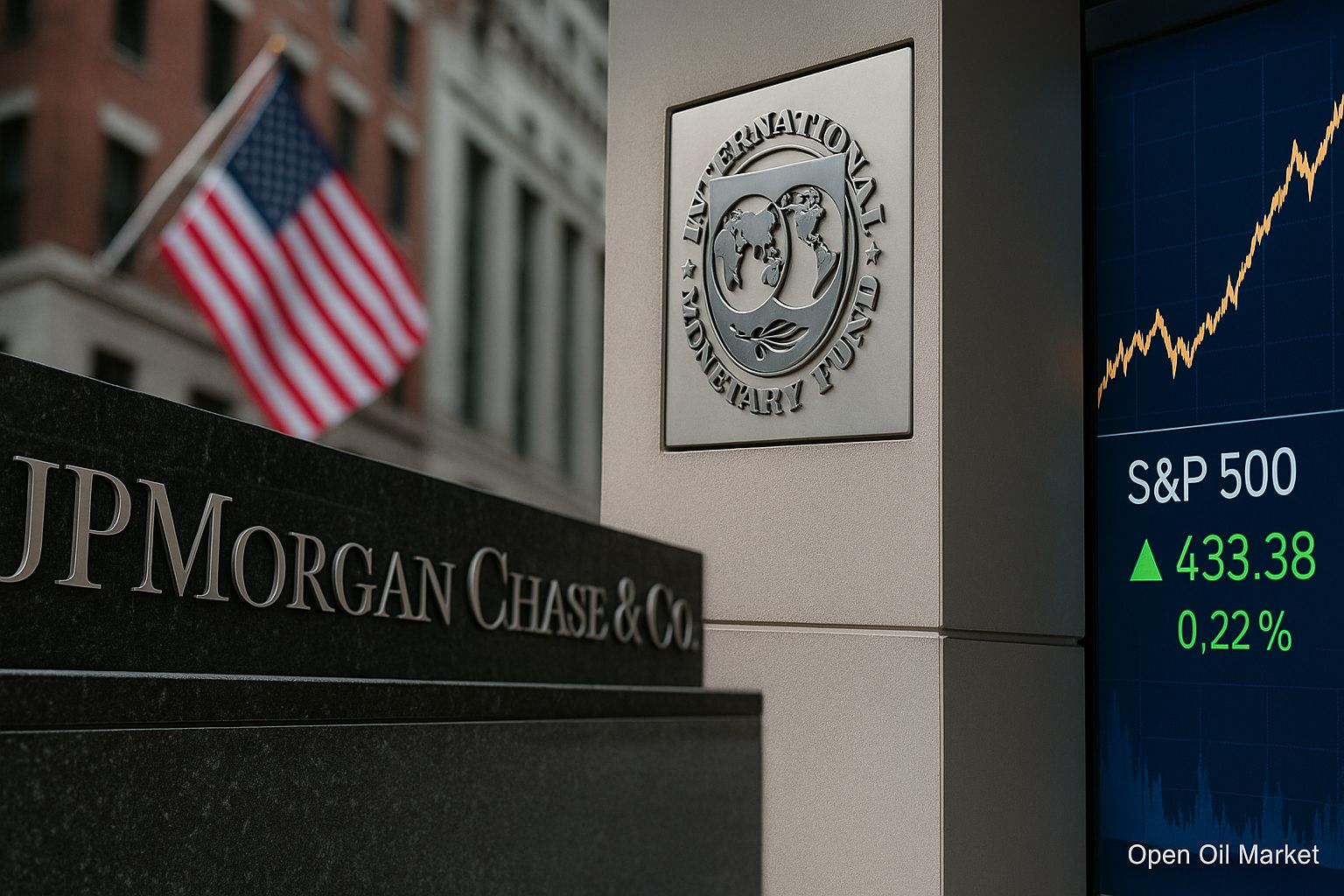
Detailed Review of Economic Events and Corporate Reports for October 14, 2025. Annual Meetings of the IMF and World Bank (Day 2), Start of the Official Earnings Season in the U.S., Introduction of New U.S. Import Tariffs on Lumber and Furniture, Publication of the RBA Minutes, Monthly IEA Oil Market Report, ZEW Sentiment Indices for Germany and the Eurozone, as well as Speeches by Fed Chair Jerome Powell and Bank of England Governor Andrew Bailey.
Tuesday presents a busy agenda for financial markets: in the Asia-Pacific region, attention will be focused on the minutes from the latest Reserve Bank of Australia meeting; in Europe, the spotlight will be on the ZEW Economic Sentiment Index for Germany and the Eurozone; meanwhile, the global backdrop is shaped by the outcomes of the annual IMF/World Bank forum and U.S. trade measures. In the U.S., the kickoff of the earnings season takes center stage as major banks begin releasing their third-quarter results, setting the tone for the S&P 500 and risk assets. Additionally, investors will assess monetary policy signals from Fed Chair J. Powell amidst expectations of a rate cut, alongside comments from Bank of England Governor E. Bailey. The energy sector will closely monitor the IEA oil report against a backdrop of price volatility. All these factors are interconnected: central bank signals ↔ bond yields ↔ corporate profits ↔ commodities ↔ investor sentiment.
Macroeconomic Calendar (Moscow Time)
- 03:30 — Australia: Publication of the minutes from the last RBA meeting.
- 11:00 — International Energy Agency: Monthly oil market report.
- 12:00 — Germany: ZEW Economic Expectations Index (October).
- 12:00 — Eurozone: Aggregate ZEW Sentiment Index (October).
- 19:20 — USA: Speech by Fed Chair Jerome Powell.
- 20:00 — United Kingdom: Speech by Bank of England Governor Andrew Bailey.
Global Economy: IMF Forum and Trade Barriers
- Annual IMF and World Bank Meetings: On the second day of the global financial forum, discussions focus on the state of the global economy. Key topics include GDP growth rates for 2025-2026, efforts to combat inflation, and risks to financial stability. The views of central bank leaders and finance ministers will set the tone for expectations: markets are watching whether global regulators will signal further policy easing or warn of new challenges (debt burden, geopolitics).
- U.S. Tariffs: Starting October 14, the United States is implementing import tariffs on a range of lumber and furniture products (10% on foreign lumber and 25% on certain furniture). These protective measures aim to support domestic industries but may lead to increased costs for construction materials and retail expenses. Investors are evaluating the potential reactions from trading partners (such as Canada and China) and the impact on inflation: escalating trade tensions could temporarily dampen risk appetite in global markets.
Monetary Policy: Signals from Central Banks
- RBA Minutes (Australia): The details of the last Reserve Bank of Australia meeting will provide context for the rate decision. If the minutes emphasize slowing inflation and risks to growth, this would strengthen expectations for further rate cuts. Soft rhetoric could weaken the Australian dollar and support the Australian stock index, whereas mention of lingering inflationary pressures may heighten caution in the Asia-Pacific markets.
- Jerome Powell's Speech (Fed): Fed Chair Jerome Powell's late-night address is a pivotal moment for currency and debt markets. Investors will be looking for hints on the Fed's next steps: confirmation of a dovish stance (amid expected rate cuts by the end of the month) will boost stock prices and weaken the dollar. Conversely, hawkish comments about persistently high inflation or a strong labor market may increase Treasury yields and trigger sell-offs in risk assets.
- Andrew Bailey's Commentary (Bank of England): Following closely is the speech by the Bank of England Governor. His assessment of the UK's economic and inflationary prospects is crucial for the dynamics of the pound and gilt markets. If Bailey suggests that the cycle of rate hikes in the UK has ended and that easing may be required as inflation declines, this could support the British stock market and weaken the pound. A more hawkish position, conversely, could increase volatility in the UK gilt market and strengthen the pound.
Oil Market: IEA Report
- Supply and Demand Overview: The International Energy Agency's (IEA) monthly oil report will revise forecasts for global demand and production. Any downward revision of oil demand estimates for the end of 2025 could exert downward pressure on Brent and WTI prices, while indications of a supply deficit (e.g., due to OPEC+ restrictions or stock drawdowns) could support price increases.
- Market Reaction: Market participants will closely analyze data on commercial stocks and production levels in non-OPEC countries. The IEA report could adjust expectations regarding market balance: the oil and gas sector equities (both in the S&P 500 and on MOEX) may show increased volatility in the event of unexpected changes in forecasts.
Europe: ZEW Sentiment Indicators
- Germany – ZEW Index: The ZEW Economic Expectations Index for October will reflect the sentiment of professional investors regarding the prospects for the German economy. An improvement in the index (less pessimism) may support European equities, particularly in the financial and industrial sectors, and bolster the euro. However, a deterioration in the index, continuing the trend of weakness due to issues in industry and exports, may heighten recession fears in Germany and apply pressure on the DAX and euro exchange rate.
- Eurozone – Aggregate ZEW Index: A similar survey for the Eurozone will indicate overall investor optimism across the EU. Positive dynamics in the ZEW for the Eurozone signal a potential improvement in economic activity in the second half of the year, which could boost confidence in the European market. Conversely, weak readings confirm sluggish recovery and may strengthen expectations for more accommodative ECB policy.
Earnings Reports: Before Market Open (BMO)
- JPMorgan Chase (JPM): The largest U.S. bank opens the earnings season, providing a benchmark for the health of the banking sector. Investors will focus on net interest income dynamics amid high rates, lending volumes, and reserves for potential losses. Strong results from JPMorgan could set a positive tone for the entire financial sector of the S&P 500.
- Wells Fargo (WFC): The retail-focused banking giant will report earnings, with key metrics being mortgage lending and interest margin. The market will assess how rising rates have impacted lending activity and profitability, along with management's comments on asset quality and loan demand.
- Citigroup (C): The multinational bank will present results crucial for understanding the state of investment banking services and global markets. Market participants will pay attention to trading and investment banking revenues, as well as the progress of Citi's business restructuring. Any surprises in Citigroup's report may impact sentiment in the U.S. and European financial sectors.
- Goldman Sachs (GS): Goldman Sachs's report will reveal the extent of the recovery in merger, acquisition, and IPO activity, which are vital for commission income. Additionally, the focus will be on the trading division’s performance amid volatile markets. Comments from Goldman’s management regarding investment banking prospects will serve as a barometer for Wall Street assessments.
- BlackRock (BLK): The world’s largest asset management firm will report on fund flows and assets under management (AUM). Growth in AUM and a positive net capital inflow signal investor confidence, while outflows may indicate caution. Furthermore, the market will evaluate BlackRock's comments on the ETF market and demand for investment products amid market volatility.
- Johnson & Johnson (JNJ): The healthcare conglomerate and sector bellwether will present financial results, with pharmaceutical and medical device sales being key areas of interest. Investors will focus on earnings forecasts, trends in sales of key drugs, and the impact of cost inflation. A successful quarter for J&J will bolster confidence in the healthcare sector, while weak metrics could heighten concerns regarding demand for pharmaceutical products.
Earnings Reports: After Market Close (AMC)
- At the close of business on October 14, no major corporate publications are expected. The majority of technology companies and industrial leaders will release their results later in the season. Investors will utilize this pause to analyze the early bank reports and prepare for the wave of earnings releases in the coming days.
Other Regions and Indices: Euro Stoxx 50, Nikkei 225, MOEX
- Euro Stoxx 50 (Europe): In the European segment, October 14 will be relatively calm in terms of corporate releases—there are no significant reports from the eurozone blue chips. Market tone is set by macroeconomic indicators (ZEW indices) and global factors, such as Powell's speeches and commodity price dynamics. The European stock index will react accordingly to these external signals.
- Nikkei 225 (Japan): In Japan, the financial reporting season for the 2025 fiscal year (April–September) is ramping up closer to the end of October. No major reports are scheduled in Tokyo for October 14, thus the Japanese market will look to external drivers – currency fluctuations and global central bank rhetoric. A stable yen and a positive external backdrop will support the Nikkei, while negative news from abroad could hinder growth.
- MOEX (Russia): In the Russian market, the publication of individual operating results and interim reports continues. Focus is on data from specific companies in the energy and consumer sectors; however, most major Russian corporations traditionally release their financial results for the nine months only at the end of October to early November. The Moscow Exchange index will likely follow the sentiments in global markets and oil price dynamics while awaiting local drivers.
Conclusion: Key Takeaways for Investors
- Start of Earnings Season in the U.S.: The results from JPMorgan, Goldman Sachs, Wells Fargo, Citigroup, and other banks will set the tone for the entire market; it's essential to assess whether corporate profits meet expectations and how the reports will influence the S&P 500 index and the financial sector.
- Fed and Bank of England Rhetoric: Speeches by Jerome Powell and Andrew Bailey may lead to reassessment of interest rate expectations; sharp statements could prompt movement in bond yields, the dollar, and the pound, consequently leading to volatility in stock markets.
- IEA Oil Report: New forecasts regarding supply and demand balance in the oil market will affect the price dynamics of energy resources; it's prudent to monitor responses from oil and gas company stocks and currencies of oil-exporting countries.
- U.S. Trade Measures: The introduction of tariffs on lumber and furniture may impact segments of the construction and furniture retail sectors; it's vital for investors to understand how these tariffs will affect company costs and relations between the U.S. and major trading partners.
- European Sentiment Indicators: An unexpected increase or decline in ZEW indices will impact forecasts for the EU economy; this will reflect on the euro exchange rate, the European banking sector, and, more broadly, on risk appetite in emerging markets, including the CIS region.




